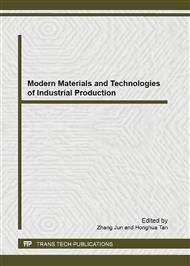p.261
p.266
p.273
p.277
p.280
p.287
p.293
p.297
p.304
Cellulose-Based Biodegradable Packaging Materials of Antimicrobial
Abstract:
In recent years, with the requirements of environmental protection of packaging materials improve, biodegradable antibacterial materials more and more attention to. This paper to can hair sex polystyrene as main raw materials, and by the synthesis of biodegradable bacteriostasis of study on the properties of packaging materials. The results shows that can hair sex polystyrene as the main raw material made by injection molding process thickness of 0.25 mm plate, and influence factors of sheet material performance, get the film material performance is the ideal process parameters. According to People's Republic of China national standard GB/T1040-92"plastic tensile properties test method" and GB/T20197-2006"degradable plastics the definition, classification, signs and degrade the performance requirements," as determined by the experimental method for testing. The orthogonal experiment results show that can hair sex polystyrene usage: 6 g; Microcrystalline cellulose usage: 0.2g; The antibacterial agent type: silver nanotio2 in the system performance and degrade the performance of the material mechanics and antibacterial good performance.
Info:
Periodical:
Pages:
280-283
Citation:
Online since:
September 2013
Authors:
Price:
Сopyright:
© 2013 Trans Tech Publications Ltd. All Rights Reserved
Share:
Citation:


